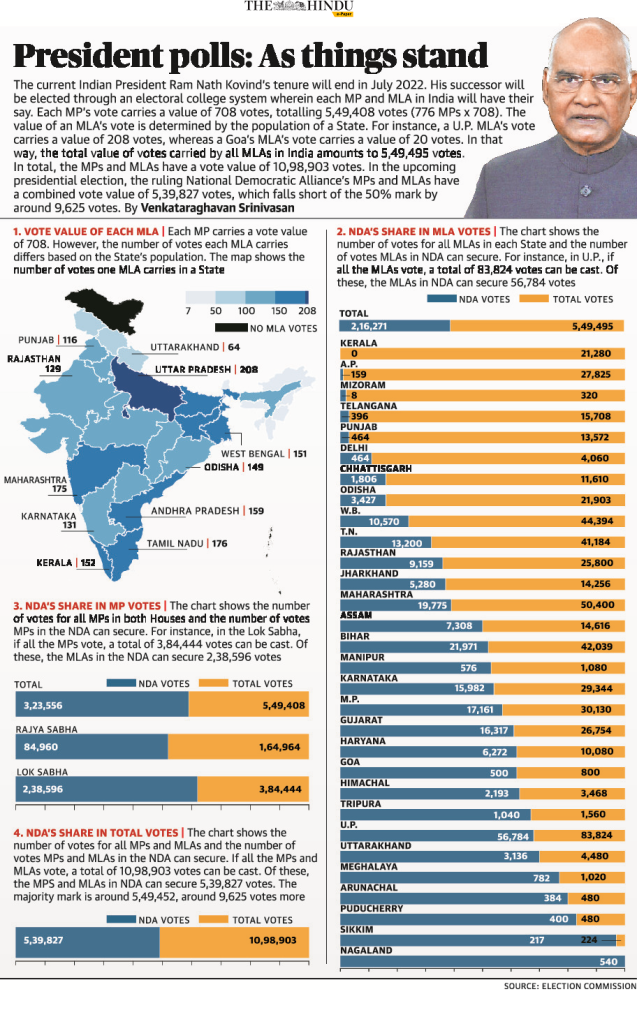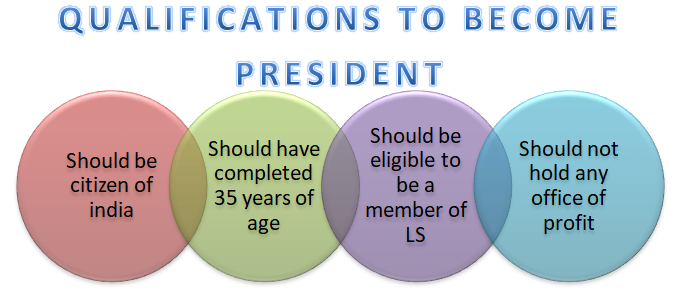Context:
The value of the vote of an MP in the presidential polls to be held in July is likely to go down to 700 from 708 due to the absence of a Legislative Assembly in Jammu and Kashmir.

Relevance:
GS II- Polity and Governance
Dimensions of the Article:
- How is the President elected?
- Qualifications for Election as President
- What is the value of each vote and how is it calculated?
- What is required to secure a victory?
How is the President elected?
- The Indian President is elected through an electoral college system, wherein the votes are cast by national and State-level lawmakers.
- The elections are conducted and overseen by the Election Commission (EC) of India.
- The President is elected not directly by the people but by members of electoral college consisting of:
- The elected members of both the Houses of Parliament
- The elected members of the legislative assemblies of the states
- The elected members of the legislative assemblies of the Union Territories of Delhi and Puducherry.
- This means, in the upcoming polls, the number of electors will be 4,896 — 543 Lok Sabha MPs, 233 MPs of the Rajya Sabha, and 4,120 MLAs of all States, including the National Capital Territory (NCT) of Delhi and Union Territory of Puducherry.
- Before the voting, comes the nomination stage, where the candidate intending to stand in the election, files the nomination along with a signed list of 50 proposers and 50 seconders.
- These proposers and seconders can be anyone from the total of 4,896 members of the electoral college from the State and national level.
Qualifications for Election as President
- He should be a citizen of India.
- He should have completed 35 years of age.
- He should be qualified for election as a member of the Lok Sabha.
- He should not hold any office of profit under the Union government or any state government or any local authority or any other public authority. A sitting President or Vice-President of the Union, the Governor of any state and a minister of the Union or any state is not deemed to hold any office of profit and hence qualified as a presidential candidate.

What is the value of each vote and how is it calculated?
- A vote cast by each MP or MLA is not calculated as one vote.
- There is a larger vote value attached to it.
- The fixed value of each vote by an MP of the Rajya Sabha and the Lok Sabha is 708.
- Meanwhile, the vote value of each MLA differs from State to State based on a calculation that factors in its population vis-a-vis the number of members in its legislative Assembly.
- As per the Constitution (Eighty-fourth Amendment) Act 2001, currently, the population of States is taken from the figures of the 1971 Census.
- This will change when the figures of the Census taken after the year 2026 are published.
- The value of each MLA’s vote is determined by dividing the population of the State by the number of MLAs in its legislative Assembly, and the quotient achieved is further divided by 1000.
- Uttar Pradesh for instance, has the highest vote value for each of its MLAs, at 208.
- The value of one MLA’s vote in Maharashtra is 175, while that in Arunachal Pradesh is just 8.
- The total votes of each Legislative Assembly are calculated by multiplying the vote value of each MLA by the number of MLAs.
- Finally, based on these values, the total number of votes of all Rajya Sabha and Lok Sabha MPs would be 5,59,408 (776 MPs X 708), and the total votes of all MLAs from State Legislative Assemblies would come up to 5,49,495.
- Thus, the grand total vote value of the whole electoral college comes up to 10,98,903.
What is required to secure a victory?
- A nominated candidate does not secure victory based on a simple majority but through a system of bagging a specific quota of votes.
- While counting, the EC totals up all the valid votes cast by the electoral college through paper ballots and to win, the candidate must secure 50% of the total votes cast + 1.
- Unlike general elections, where electors vote for a single party’s candidate, the voters of the electoral college write the names of candidates on the ballot paper in the order of preference.
-Source: The Hindu



